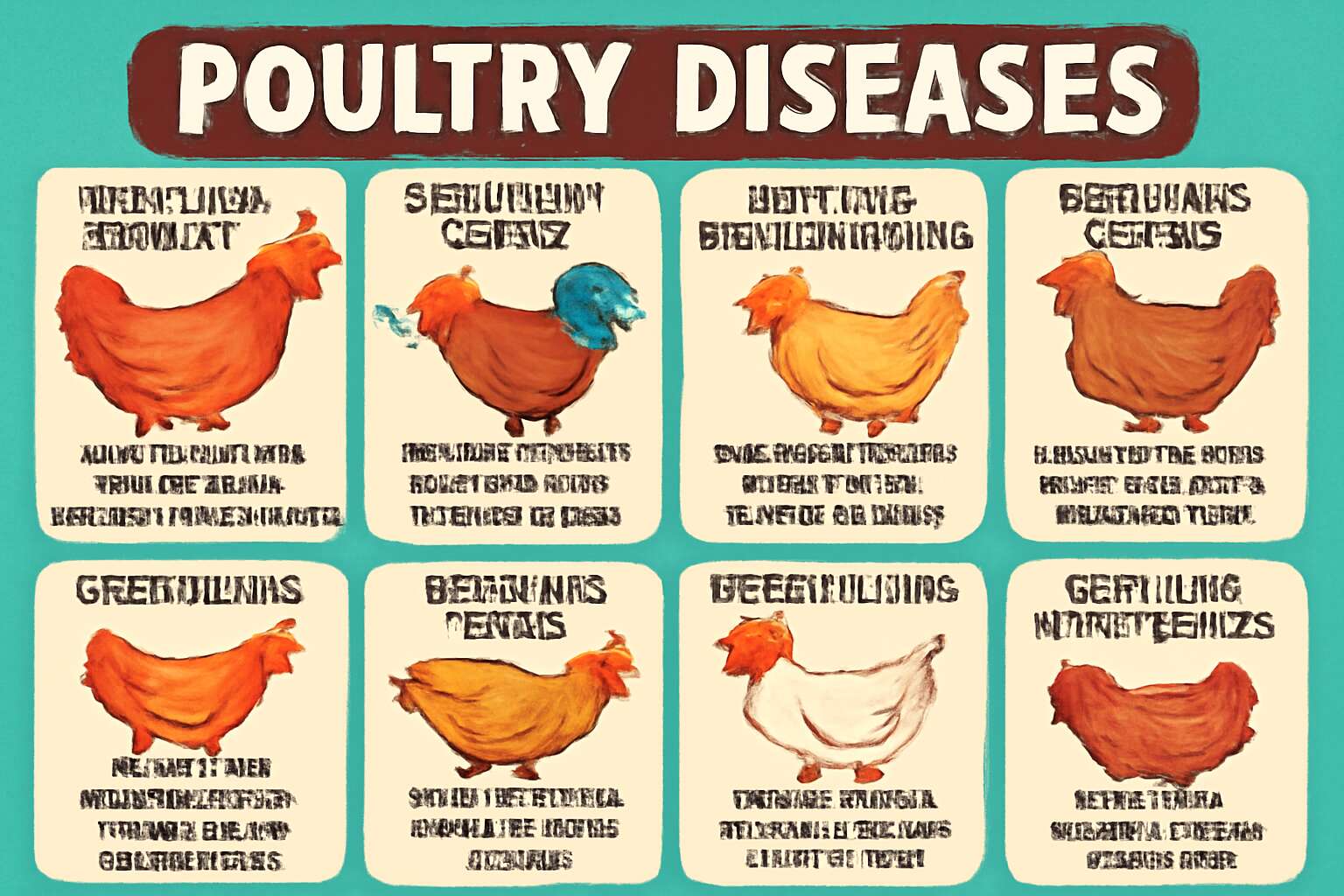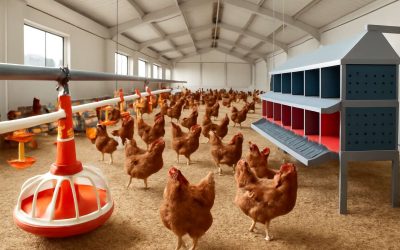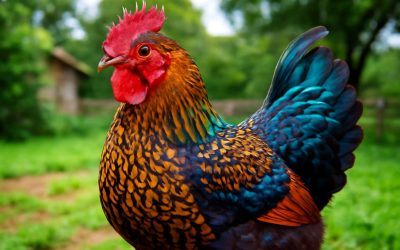Understanding Poultry Diseases
Overview of Poultry Diseases – Types and common causes of diseases affecting poultry
Approximately 70% of poultry farm losses in South Africa stem from overlooked or misdiagnosed diseases. Understanding poultry diseases is not just a matter of health—it’s a strategic move to safeguard your investment. The poultry diseases chart reveals a complex web of afflictions that can strike unexpectedly, transforming a thriving flock into a ghost town overnight. From viral outbreaks to bacterial invasions, the spectrum is wide, yet certain culprits remain the most common.
Among these, infectious bronchitis, avian influenza, and coccidiosis are notorious for their rapid spread and devastating impact. The common causes of poultry diseases include poor ventilation, contaminated feed, and inadequate biosecurity measures. Recognizing the signs early can mean the difference between a controlled outbreak and a catastrophic loss. To navigate this treacherous landscape, farmers rely heavily on a detailed poultry diseases chart, which maps symptoms, causes, and preventative strategies with precision.
Importance of Disease Identification – Why early detection and diagnosis are crucial
In the high-stakes world of poultry farming, the difference between a flourishing flock and devastating loss often hinges on a single moment of awareness. An astonishing 70% of poultry farm losses in South Africa are a direct result of overlooked or misdiagnosed diseases, underscoring the critical importance of timely recognition. The poultry diseases chart serves as an indispensable tool—acting as both a navigational map and a warning system—guiding farmers through the labyrinth of symptoms, causes, and preventative measures.
Early detection and diagnosis are the linchpins of effective disease management. When signs of illness are caught swiftly, farmers can implement targeted interventions that prevent the escalation of outbreaks. Delay, conversely, often results in exponential spread, causing not only economic setbacks but also jeopardizing the health of entire flocks. The poultry diseases chart offers clarity amid chaos, transforming complex symptomatology into actionable insights. By understanding these patterns, farmers can act decisively to safeguard their investment and uphold biosecurity standards.
Role of a Poultry Diseases Chart – How visual aids assist farmers and veterinarians
Understanding poultry diseases is a puzzle that can make or break a farm’s success. This is where a well-designed poultry diseases chart becomes an invaluable asset—transforming complex information into a visual guide that reveals the hidden patterns of illness. Visual aids like these help farmers and veterinarians quickly identify symptoms, making the difference between swift containment and catastrophic spread.
With the poultry diseases chart as a reference, farmers can navigate the often confusing landscape of signs and causes with confidence. It’s more than just a diagram; it’s a strategic tool that enhances decision-making and sharpens biosecurity measures. By offering a clear, visual representation of disease symptoms—ranging from respiratory distress to digestive anomalies—it acts as a bridge between observation and action.
In the relentless environment of South African poultry farming, every second counts. The poultry diseases chart empowers farmers to spot trouble early, ensuring timely intervention. This visual aid isn’t just about diagnosis—it’s about safeguarding livelihoods, protecting flocks, and maintaining a resilient poultry industry.
Common Poultry Diseases and Their Symptoms
Infectious Diseases
In the intricate dance of poultry farming, few things are as insidious as infectious diseases that stealthily undermine flock health. Recent studies reveal that up to 30% of poultry losses in South Africa can be attributed to delayed recognition of common diseases. Recognizing symptoms early becomes paramount—otherwise, what begins as a subtle lethargy or slight feather loss can escalate into catastrophic outbreaks. Poultry diseases chart serve as invaluable tools, illuminating the often-overlooked signs that betray underlying health threats.
Common poultry diseases such as avian influenza, Newcastle disease, and infectious bronchitis manifest through a spectrum of symptoms—ranging from respiratory distress to sudden mortality. For instance, infectious bronchitis may cause a drop in egg production and coughing, while Newcastle disease often presents with neurological signs and paralysis. By consulting a comprehensive poultry diseases chart, farmers and veterinarians can identify these symptoms swiftly, enabling timely intervention to curtail disease spread and preserve flock vitality.
Bacterial Diseases
In the bustling tapestry of South African poultry farms, bacterial diseases often lurk as silent predators—unseen, yet deadly. Recognizing the subtle signs of these afflictions can mean the difference between a thriving flock and a devastating outbreak. A poultry diseases chart becomes an essential compass in this battle, illuminating the often-overlooked symptoms that betray bacterial invasions.
Common bacterial diseases such as Salmonella and E. coli can cause a range of distressing symptoms. Chickens may exhibit lethargy, diarrhea, and a sudden drop in feed consumption, all warning signals of deeper ailments. Salmonella, in particular, can lead to severe septicemia, causing rapid mortality if not identified promptly. A poultry diseases chart serves as a vital reference, guiding farmers through the labyrinth of symptoms with clarity and precision.
To truly grasp the severity, consider these typical signs:
- Swollen wattles or combs
- Diarrhea with mucus or blood
- Unusual lethargy or weakness
- Loss of appetite and weight
With each symptom carefully mapped out on a poultry diseases chart, the pathway to swift diagnosis becomes clearer. Early detection of bacterial diseases empowers farmers to act decisively—saving countless lives and safeguarding the vitality of their poultry enterprise. The importance of understanding these bacterial signatures cannot be overstated in the ongoing quest for healthy flocks and sustainable farming in South Africa.
Parasitic Diseases
Parasitic diseases in poultry, though often overshadowed by bacterial and viral threats, possess an insidious capacity to erode flock health from within. These microscopic invaders—mites, lice, and worms—wreak havoc silently, their presence often obscured until the damage is unmistakable. A comprehensive poultry diseases chart becomes an indispensable tool, illuminating the subtle signs that betray parasitic infestations.
Birds suffering from parasitic diseases may exhibit a constellation of symptoms that seem innocuous at first glance—persistent scratching, feather loss, or pale combs. Yet, beneath these superficial signs lurk deeper issues: anemia, reduced egg production, and sluggish growth. Recognizing these clues early on can prevent catastrophic outbreaks, preserving both the vitality of the flock and the economic stability of South African poultry farms.
- Intense itching and feather plucking
- Visible mites or lice on skin and feathers
- Drop in egg production or abnormal eggshells
- Weakness, lethargy, or unsteady gait
Each symptom, when mapped meticulously on a poultry diseases chart, guides farmers through the labyrinth of diagnosis with clarity and precision. The fight against parasitic diseases hinges on this visual clarity—transforming confusing signs into actionable insights, and ultimately, into healthier, more resilient poultry flocks.
Viral Diseases
Viral diseases in poultry are among the most formidable foes confronting South African farmers. These invisible enemies can spread swiftly through flocks, often leaving behind a trail of silent suffering. Symptoms such as sudden drops in egg production, respiratory distress, or swelling around the eyes and wattles can be early clues. When mapped onto a poultry diseases chart, these signs become clear landmarks guiding diagnosis and response.
For example, Newcastle disease, a notorious viral threat, manifests through trembling, twisted necks, and a sharp decline in productivity. Similarly, infectious bronchitis can cause coughing, sneezing, and abnormal eggs with deformities. Recognizing these symptoms early is crucial, as viral diseases tend to spread rapidly, threatening the entire flock’s health and productivity.
Understanding the subtle nuances of each viral ailment transforms the poultry diseases chart from a mere diagram into a vital tool—illuminating the path toward swift intervention and healthier poultry farms. When symptoms are accurately identified, farmers can act decisively, safeguarding their flocks from devastating outbreaks and ensuring their livelihoods remain resilient amidst the challenges of South Africa’s poultry industry.
Visual Elements of a Poultry Diseases Chart
Color Coding and Symbols – How colors and icons improve diagnosis
Visual elements of a poultry diseases chart are more than just eye-catching—they are vital for accurate diagnosis and swift intervention. When colors and symbols are used thoughtfully, they transform complex information into an intuitive language that both seasoned farmers and veterinarians can understand instantly. Bright red, for example, often signals highly contagious or severe conditions, demanding immediate attention, while softer hues may indicate less critical ailments. This strategic use of color coding reduces misinterpretation and accelerates decision-making, especially in high-pressure environments.
Icons and symbols further enhance clarity, serving as visual shorthand that cuts through language barriers and technical jargon. For instance, a droplet icon might denote bacterial infections, while a parasite silhouette emphasizes parasitic diseases. These visual cues create a layered communication system—one that guides users through the intricacies of poultry health with remarkable ease. A well-designed poultry diseases chart leverages these visual elements to foster rapid recognition and a deeper understanding of disease progression, ultimately safeguarding flocks and supporting sustainable poultry farming practices in South Africa.
Illustrative Diagrams – Use of sketches and images for clarity
Visual clarity is the cornerstone of an effective poultry diseases chart, especially in bustling South African farms where every second counts. Illustrative diagrams—those charming sketches and vivid images—serve as the visual language that bridges the gap between complex pathology and practical understanding. They transform abstract symptoms into recognizable images, making diagnosis less of a guessing game and more of a confident assertion.
By incorporating detailed sketches of affected organs, feather conditions, or typical postures, a poultry diseases chart becomes a vivid tableau of potential health issues. These images provide instant recognition, even for the novice farmer, and reduce reliance on lengthy technical descriptions. Consider a diagram showing feather loss patterns or comb deformities—such visuals are invaluable in quick on-site assessments.
Sometimes, a simple, clear image beats a paragraph of text. In fact, a well-designed poultry diseases chart often integrates these sketches with concise labels or numbered references, guiding users seamlessly through the diagnostic process. It’s an elegant dance of visuals and words—making health management not only more accessible but also more precise in the busy landscapes of South African poultry farms.
Comparison Tables – Differentiating similar symptoms among diseases
In the shadowed corridors of poultry health, a well-crafted poultry diseases chart becomes an essential lantern, illuminating the often murky realm of avian ailments. Among its vital features are the visual elements—comparison tables that serve as the oracles of diagnosis. These tables are not merely rows of facts but a tapestry of contrasts, designed to differentiate similar symptoms that can confound even the most seasoned farmer in South Africa’s bustling farms.
Color coding and symbols within these comparison tables are like secret runes—each hue and icon whispering crucial clues about distinct diseases. For instance, a red cross might mark a bacterial infection, while a violet symbol signals a viral menace. This visual language transforms complex data into an intuitive guide, allowing quick recognition of ailments that threaten the flock’s vitality.
By weaving together these visual elements—distinctive shades, clear icons, and structured comparisons—the poultry diseases chart becomes a masterful tool in the fight against poultry health crises. It’s a silent sentinel, guiding farmers through the labyrinth of symptoms with artistry and precision, even amidst the chaos of a busy South African farm.
Benefits of Using a Poultry Diseases Chart
Quick Diagnosis – Speeding up identification in the field
In the bustling world of poultry farming, time is often measured in seconds—particularly when it comes to diagnosing diseases. A well-structured poultry diseases chart acts as an invaluable tool, transforming what could be a frantic search for clues into a swift, almost artful, diagnosis. This rapid identification process is crucial; the longer a disease festers, the greater the risk of a full-blown outbreak that can decimate flocks and devastate livelihoods.
By harnessing a poultry diseases chart, farmers and veterinarians gain a visual language that transcends mere words—colors, symbols, and diagrams come together to form an intuitive map of ailments. This not only accelerates decision-making but also minimizes the margin for error, especially in the heat of a crisis. Think of it as having a seasoned poultry health expert at your fingertips, guiding you through the labyrinth of symptoms with clarity and precision.
In essence, a poultry diseases chart is the unsung hero of disease management: a quick diagnosis that saves time, resources, and ultimately, the health of your flock. Its strategic use ensures that interventions are timely, effective, and rooted in a thorough understanding of poultry diseases, making it an indispensable asset for every poultry farmer committed to excellence.
Educational Tool – Enhancing farmer and vet knowledge
In the intricate dance of poultry farming, knowledge is the most valuable currency. A comprehensive poultry diseases chart offers more than just visual cues; it is an educational beacon that elevates the expertise of both farmers and veterinarians. By translating complex symptoms into a clear, accessible format, the chart fosters a deeper understanding of poultry health—an essential component in safeguarding livelihoods across South Africa.
This invaluable tool enhances learning through intuitive design, often incorporating color coding and symbols that serve as quick-reference guides. It bridges the gap between theory and practice, empowering farmers to recognize early warning signs and make informed decisions swiftly. For veterinarians, it functions as a dynamic reference, streamlining diagnosis and treatment planning, ultimately reducing the risk of disease spread.
Investing in a poultry diseases chart is akin to cultivating an ever-expanding repository of knowledge—an asset that nurtures confidence, sharpens diagnostic skills, and fortifies the resilience of poultry flocks. When every second counts in disease management, such an educational tool becomes a vital ally, transforming uncertainty into clarity and chaos into control.
Disease Management – Guiding effective treatment and prevention
In the bustling world of South African poultry farms, every second counts when it comes to disease management. A well-crafted poultry diseases chart isn’t just a reference tool—it’s a gateway to swift, confident decision-making. By providing clear visual cues and straightforward symptom recognition, this educational resource transforms complex diagnostics into an accessible, almost magical guide. Farmers and veterinarians alike find themselves empowered, able to navigate the labyrinth of poultry health with ease and precision.
Its benefits extend beyond mere identification. A poultry diseases chart acts as a compass for effective treatment and prevention strategies. It helps prioritize actions based on accurate diagnosis, reducing the risk of outbreaks spreading through flocks. The visual distinctions—color coding, symbols, and diagrams—create an intuitive map that guides users through the often bewildering maze of poultry illnesses. When disease strikes, this tool becomes a vital ally in maintaining the vitality and resilience of poultry populations across South Africa.
How to Choose the Right Poultry Diseases Chart
Coverage and Specificity – Finding charts tailored to your poultry type and region
Choosing the right poultry diseases chart isn’t a matter of mere aesthetics; it’s an essential decision that can determine the fate of your flock. In regions like South Africa, where climate and local pathogens vary dramatically, a tailored chart becomes a lifeline. A generic chart might miss critical regional diseases, leaving you vulnerable. Instead, seek a poultry diseases chart that offers region-specific insights, covering prevalent diseases unique to your environment.
Moreover, the level of specificity in the chart should match your operational scale. Whether managing a small backyard coop or a large commercial farm, the chart should provide clear, detailed information that aligns with your poultry type. For instance, charts focusing on broilers versus layers often differ in disease profiles and management strategies. Remember, a well-chosen poultry diseases chart will combine regional relevance with targeted coverage, ensuring you’re equipped to identify and tackle issues promptly and accurately.
User-friendliness – Ease of understanding for different users
Choosing a poultry diseases chart isn’t just a matter of picking the prettiest picture or the clearest font. It’s about user-friendliness—ensuring that farmers, vets, and even weekend hobbyists can quickly grasp critical information during a health crisis. After all, when poultry health hangs in the balance, clarity isn’t just a luxury; it’s a lifeline!
Opt for a poultry diseases chart that employs straightforward language and simple layouts—no one wants to decipher hieroglyphics while chickens are flapping wildly around. Look for charts with intuitive symbols, easy-to-read labels, and a logical flow that guides you from symptom recognition to potential diagnoses. Remember, in the busy world of poultry farming, a chart that’s too complicated is as useless as a screen door on a submarine.
In South Africa’s diverse climate and disease landscape, a good poultry diseases chart should also adapt to your operational scale. Whether managing a handful of backyard hens or a sprawling commercial farm, your chart should be tailored to your level of expertise and the complexity of your flock. The right chart makes diagnosis a breeze—saving time, reducing stress, and keeping your birds happy and healthy!
Update Frequency – Ensuring the chart reflects current knowledge
In the unpredictable world of poultry farming, staying ahead of emerging threats hinges on the relevance of your poultry diseases chart. Outdated information can turn a manageable health issue into a full-blown crisis—something no farmer or vet wants to face. That’s why regularly updating your poultry diseases chart is crucial for accurate diagnosis and swift action. A chart that reflects the latest research, vaccine developments, and regional disease patterns ensures your flock remains protected against evolving challenges.
To maintain its effectiveness, consider the update frequency of your poultry diseases chart. Ideally, it should be revised at least once a year, especially in regions like South Africa where climate fluctuations influence disease outbreaks. Some charts may require more frequent updates—every six months—if new strains or outbreaks are identified. This constant refresh keeps your diagnostic tools sharp and your decision-making precise.
When choosing a poultry diseases chart, look for one that clearly states its last update date. This transparency guarantees you’re working with the most current knowledge, reducing the risk of misdiagnosis. Remember, in the dynamic landscape of poultry health, an up-to-date chart isn’t just a resource—it’s your frontline defense against the unseen threats lurking in your flock!
Sources and Resources for Poultry Disease Information
Veterinary References – Reliable books and journals
When confronting the complex web of poultry diseases, having access to trustworthy sources and resources for poultry disease information becomes paramount. The foundation of effective disease management hinges on reliable veterinary references—trusted books and peer-reviewed journals that offer in-depth insights into avian health. In South Africa, where poultry farming faces unique challenges, sourcing authoritative data can make the difference between swift intervention and costly outbreaks.
Veterinary reference materials such as the *Compendium of Poultry Diseases* or the *Journal of Avian Medicine* serve as invaluable tools for veterinarians and farmers alike. These sources not only provide detailed descriptions of symptoms but also elucidate pathogen behavior and transmission pathways. For those seeking quick, accessible information, online platforms and regional veterinary associations often maintain current poultry diseases chart updates, integrating the latest research findings.
To streamline diagnosis and treatment, many professionals rely on a curated list of essential resources, including:
- Regional veterinary bulletins
- Government agricultural departments’ publications
- Specialized poultry health organizations
Harnessing these sources ensures that your understanding of poultry diseases remains sharp, allowing for timely, accurate responses—an essential aspect of safeguarding your flock’s health and productivity. Remember, a well-informed decision is often the best defense against the devastating impacts of poultry diseases.
Online Platforms – Websites and mobile apps
In the bustling world of South African poultry farms, staying ahead of disease outbreaks can be a game-changer. Digital innovation has made it easier than ever to access vital poultry diseases chart updates through online platforms. These resources are often tailored to regional needs, ensuring farmers and vets receive the most relevant and current information. Whether via dedicated websites or mobile apps, having instant access to disease data can mean the difference between swift containment and devastating losses.
Many online platforms feature comprehensive poultry diseases chart visuals that use color coding and symbols for quick diagnosis. These digital tools often include interactive features such as symptom checkers or comparison tables, which help differentiate similar diseases at a glance. For example, apps like Poultry Health Tracker or regional veterinary portals integrate the latest research, ensuring your poultry diseases chart remains a reliable reference point at all times.
To enhance your diagnostic arsenal, consider exploring these digital resources:
- Regional veterinary association websites
- Government agricultural departments’ portals
- Specialized poultry health apps available for smartphones
Harnessing the power of online platforms offers a seamless way to keep your knowledge sharp and your response times swift—an essential edge in the fight against poultry diseases. With these digital tools, managing poultry health becomes less of a challenge and more of an organized, informed effort.
Government and Agricultural Agencies – Official guidelines and updates
Access to authoritative sources is paramount when navigating the complex landscape of poultry health management. Government and agricultural agencies serve as the bedrock of reliable poultry diseases chart updates, offering guidance rooted in scientific rigor and regional expertise. These official portals are often the first to disseminate critical information during outbreaks, ensuring farmers and veterinarians stay well-informed. The value of these resources extends beyond mere updates; they provide comprehensive guidelines that help interpret poultry diseases charts with clarity and confidence.
Many regional veterinary association websites host dedicated sections for poultry health, where the latest disease reports and management protocols are readily available. Similarly, government agricultural departments in South Africa publish periodic updates, ensuring that poultry farmers have access to the most current and region-specific data. For those seeking instant insights, specialized poultry health apps—often linked directly to official sources—offer a streamlined experience. These digital tools integrate the latest research findings, making the poultry diseases chart an adaptive, trusted resource in every farm setting.
By leveraging these official channels, poultry producers can enhance their disease detection capabilities. The synergy between authoritative guidelines and up-to-date poultry diseases charts creates a resilient defense against outbreaks, safeguarding both livelihoods and food security in the region. When every second counts, trusting these reputable sources ensures your response is swift, accurate, and grounded in the most current scientific understanding.




0 Comments